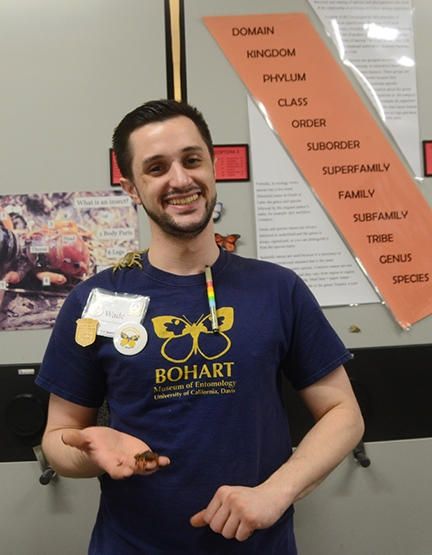
Logan, a visitor at the Bohart Museum of Entomology's recent open house on spiders and other arachnids, wowed the crowd with his knowledge of scorpions.
“Logan is only in kindergarten but he was showing his mom our arachnid drawer and describing the differences between the Emperor Scorpion, Pandinus imperator, and the Dictator Scorpion, Pandinus dictator,” said Bohart associate and scorpion scientist Wade Spencer, an undergraduate student at Bohart Museum. “Thankfully, he wasn't at all shy when I asked him to repeat what he had just said to the crowd.”
“He loved sharing his knowledge with those interested,” Spencer said. “And his mom is an arachnid saint as she supports his endeavors even while she still gets the willies from just looking at them. She told me she finds it important to keep her cool so that he may never lose his enthusiasm.”
The Bohart Museum's three-hour open house included a presentation on spiders by Jason Bond, the Evert and Marion Schlinger Endowed Chair in Insect Systematics, UC Davis Department of Entomology and Nematology. Scientists in both the Bond lab and the Bohart lab led arachnid activities, including "Eat Like a Spider" and "Catch a Moth."
Spencer and fellow Bohart associate and entomology undergraduate student Lohit Garikipati, tabled the scorpion display. The guests asked questions, gingerly touched them, and took cell phone photos.
Spencer currently has 37 scorpions of various species. Scorpions are venomous, not poisonous, he pointed out. As Professor Bond said in his talk: "Poisonous is what you eat it make you sick. Venomous means it takes toxin and it injects it into you."
"Fun fact about scorpions, Spencer said, "is that all of them are safe to eat as none of them are poisonous (toxins ingested or absorbed), but all of them (as far as we know) are venomous (containing poison(s) which are injected by some means)."
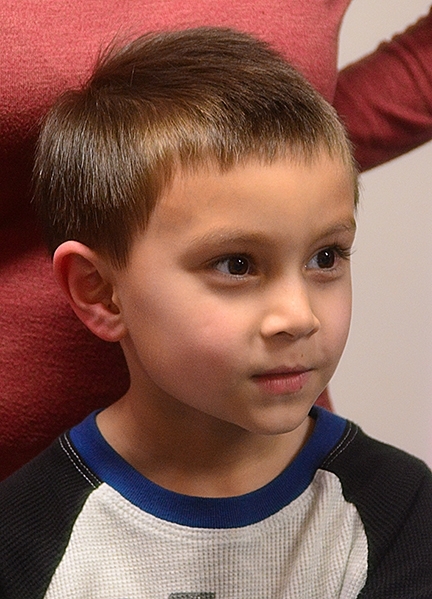
"I use the term 'medically significant' because it has the most potent venoms we know of, but I refrain and even discourage the use of the term 'dangerous' when describing scorpions and other venomous creatures," Spencer said. "It's often our own carelessness which makes them dangerous. If you live in in scorpion country, shake out your boots if you leave them outside and buy a $20 UV flashlight on Amazon. Those are simple ways to detect them and avoid being stung."
Spencer said he handles "my little Leiurus q. to show just how gentle and adorable she is so that people can have visual confirmation to back my claim that there is no such thing as a dangerous scorpion--though it should be clear I am not saying they're cuddly or friendly like a puppy. I advocate for them to be treated with caution and respect.
The UC Davis student attributes his interest in scorpions to his great-grandmother.
"My great-grandmother would always take me on afternoon picnics in the Big Tujunga Canyon Wash, a mostly dry river bed in the San Gabriel mountains in my home town of Sunland. She was a naturalist at heart and taught me about the native plants, geology, birds, mammals, reptiles, amphibians, and my favorite: the bugs. If ever we encountered a scorpion, she would stop and show me, but wouldn't kill them. Instead, starting when I was 3, she taught me that they were nothing to fear and showed me how to gently handle them. I've handled thousands ever since and not once been stung."
"I'm often asked why I'm not stung, and my response is always the same: 'It's not a cat!' By that, I mean, there's no risk of it randomly attacking me. I have scars all over my body from dogs and cats."
Spencer loves scorpions for three primary reasons:
- "Knowing their ancestors were the first animals on land about 450 million years ago."
- "Many of their venoms are being studied for use in shrinking brain tumors, sending fluorescent dyes to tumors with such specificities as to view 200 cancerous cell clusters--whereas MRIs can view 500,000 cell clusters. And some--to regulate insulin, treat arthritis, and antimicrobial components--have been used in mice with MRSA (methicillin resistant Staphylococcus aureas), completely curing them in 4 days."
- "Working with them directly and seeing how many people we have helped get over their fears has me simply head-over-heels for them."
The scorpion display drew the interest of adults and children alike. Three Brownie Girl Scouts from Vacaville giggled and comforted one another when they experienced the "Virtual Reality Spiders" demonstration conducted by medical entomologist Geoffrey Attardo, assistant professor, UC Davis Department of Entomology and Nematology. But not so the scorpion display.
"When it came to the live stuff, the girls (Kendl Macklin, 7, Jayda Navarette, 8, and Keira Yu, 8) were more calm than nervous," said Spencer, adding "I thanked them for their bravery and showing the adults that there was nothing to fear."
The Bohart Museum, directed by Lynn Kimsey, UC Davis professor of entomology, is located in Room 1124 of the Academic Surge Building on Crocker Lane. It houses nearly 8 million insect specimens, a gift shop, and a live "petting zoo" of Madagascar hissing cockroaches, stick insects or walking sticks, and tarantulas. The insect museum is open to the public Monday through Thursday, from 9 a.m. to noon, and from 1 to 5 p.m.
Attached Images:
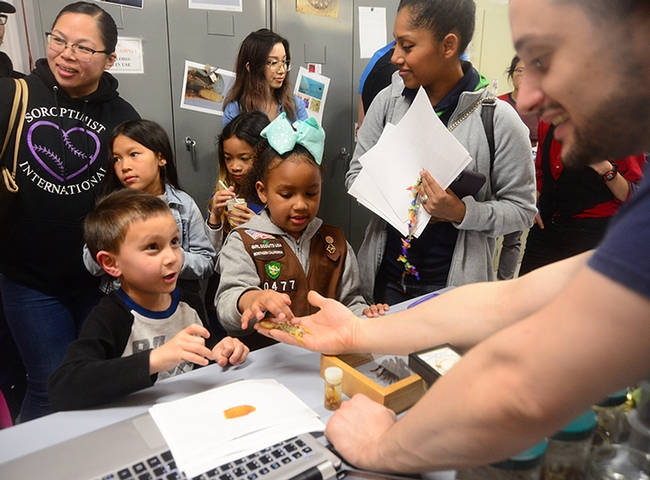
Logan Loss, 6, of Rocklin talks about scorpions to Bohart associate and scorpion scientist Wade Spencer. The kindergarten student is an avid scorpion enthusiast. Also pictured are members of the Vacaville Brownie Girl Scout Troop (from left) Jayda Navarette, Keira Yu and Kendl Macklin, front. (Photo by Kathy Keatley Garvey)
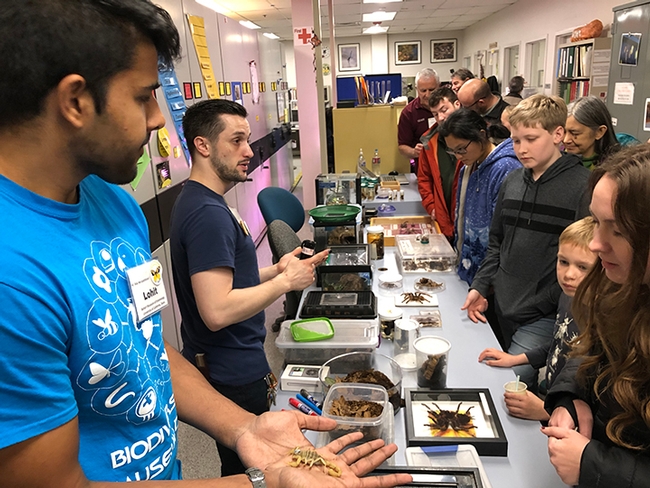
Bohart associates and entomology students Lohit Garikipati show scorpions to the crowd. (Photo by Kathy Keatley Garvey)
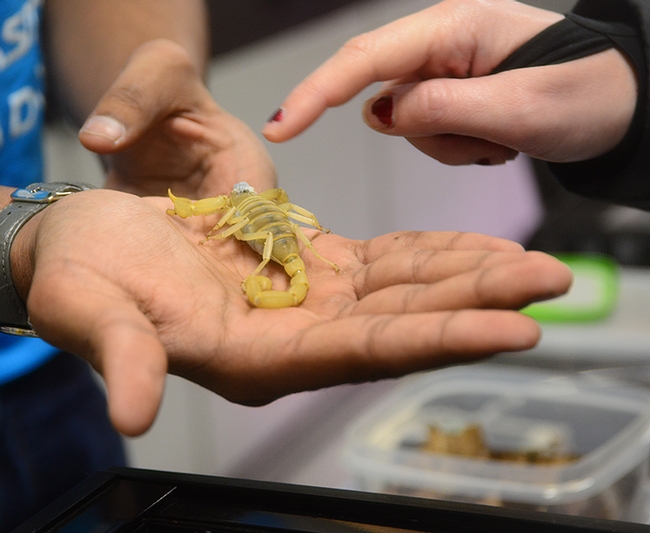
This is Wade Spencer's desert hairy scorpion named Barthlomew. (Photo by Kathy Keatley Garvey)
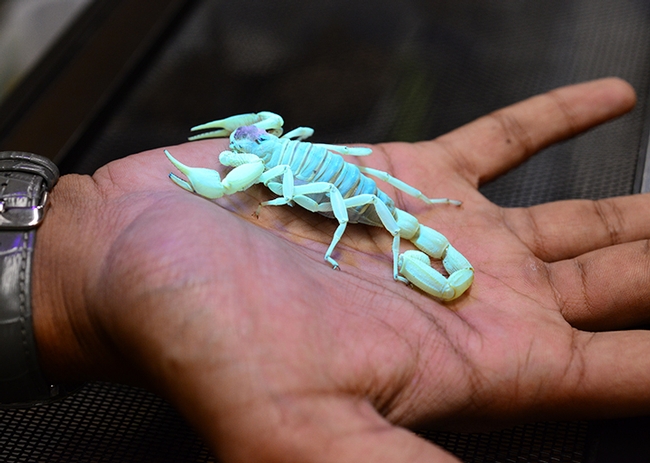
Wade Spencer's desert hairy scorpion named Barthlomew glows under UV light. (Photo by Kathy Keatley Garvey)
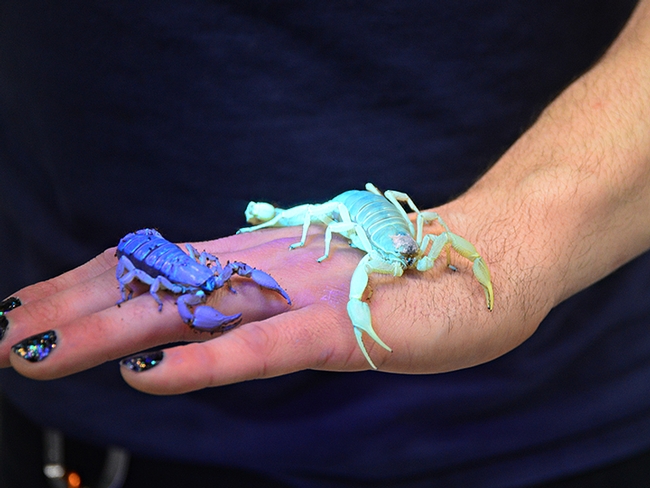
Wade Spencer holds his African burrowing scorpion (left) and desert hairy scorpion under UV light. (Photo by Kathy Keatley Garvey)